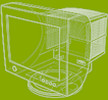History of Intel CPUs*
| 1978 |
8086 |
16-bit processor, up to 1MB RAM, available in
5,6,8 and 10 MHz, 29K transistors. |
| 1979 |
8088 |
chosen for the first IBM PC. |
| 1982 |
80286 |
up to 16MB RAM, up to 20 MHz, 134K transistors,
virtual memory and protected mode. |
| 1985 |
80386 |
32-bit processor, up to 4GB RAM,
up to 33 MHz, 275K transistors,
instruction pipelining. |
| 1989 |
80486 |
1.2M transistors,
integrated FPU, 8KB on-chip cache. |
| 1993 |
Pentium |
up to 200MHz, two 8K caches. |
| 1995 |
Pentium Pro |
RISC chip, more stages in pipeline,
on-board L2 cache. |
| 1997 |
Pentium II |
MMX instruction, dynamic execution,
up to 450MHz. |
| 1999 |
Pentium III |
SSE instruction, up to 1+GHz. |
| 2000 |
Pentium IV |
Hyper pipeline, Rapid execution engine,
Execution trace cache, 3.8+GHz. |
| 2005 |
Pentium D |
Dual core. |
|
Course overview
This course is about how computer works.
We will closely follow the book, The Elements of Computing Systems,
which teachs you how to build a modern computer from first principles.
Along the way, you will learn the basic principles about
switching devices, combinational logic,
sequential logic, computer architecture, machine language, assembly language,
virtual machine, compiler, high-level language and operating system.
Meeting time:
2:20pm-5:10pm every Tuesday
Classroom:
CSIE Room 101
Instructor:
Yung-Yu Chuang
Teaching assistants:


TA Office hours:
13:00-14:00 Tuesday, R505

14:00-15:00 Wednesday, R506

Textbook:
References:
Grading: (subject to change!)
- assignments (50%)
- class participation (5%)
- midterm quiz (20%)
- final project (25%)
Syllabus (topics we might cover):
- Combinational circuits
- Sequential circuits
- TOY architecture
- TOY programming
- Assembly language fundamentals
- Hack architecture
- virtual machine
- High-level language, Jack
- compiler
- operating system
|






